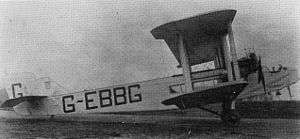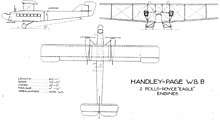Handley Page Type W
| Type W | |
|---|---|
 | |
| Twin Eagle engined W.8b | |
| Role | Airliner |
| Manufacturer | Handley Page |
| First flight | 2 December 1919 |
| Introduction | 1921 |
| Retired | 1934 |
| Primary users | SABENA Imperial Airways |
| Number built | 25 |
| Variants | Handley Page Hyderabad |
The Handley Page W.8, W.9 and W.10 were British two- and three-engine medium-range biplane airliners designed and built by Handley Page.
The W.8 (also known as the H.P.18) was the company's first purpose-built civil airliner although it was a development of the wartime Handley Page Type O/400 bomber via the O/7, O/10 and O/11 transports. It had an enclosed cabin for (in most versions) 12 passengers, along with two crew in an open cockpit, and has the distinction of being the world's first airliner to be designed with an on-board lavatory. The prototype first flew on 4 December 1919, shortly after it was displayed at the 1919 Paris Air Show at Le Bourget. The W.8 was subsequently revised to give the W.8b, W.8e (H.P.26), W.9 (H.P.27) and W.10 (H.P.30). It was also the basis for the W.8d (H.P.24), the Handley Page Hyderabad bomber.
Developments
W.8
Prototype, holding 15 passengers, powered by two 450 hp (336 kW) Napier Lion engines. The original company designation was to have been Handley Page W/400.
W.8b
To meet an Air Ministry ruling the capacity was reduced to 12 passengers and the fuel tanks were moved from the engine nacelles to above the top wing. The engines were changed from the Napier Lion to the less powerful but more economical Rolls-Royce Eagle IX. In 1921 the Air Ministry ordered three aircraft, built as the W.8b, for use by Handley Page Transport, and later by Imperial Airways, on services to Paris and Brussels.[1][2] Another aircraft was delivered to SABENA in 1924 and three more were license built by SABCA in Belgium.
W.8c
Planned alteration of W.8b for 1923, seating 16 passengers in longer passenger cabin, with radio compartment eliminated and freight capacity reduced. Fuel tanks would be moved to the underside of the top wing, and slotted ailerons would be fitted. Engines would be unchanged.[3] Never built.
W.8d
The W.8d was the initial designation for the Handley Page Hyderabad heavy bomber.
W.8e
To reduce the risks involved with engine failure, the W.8e was developed with one 360 hp (270 kW) Rolls-Royce Eagle IX in the nose and two 240 hp (180 kW) Siddeley Pumas in the normal position. The first W.8e was sold to Sabena, which had ten more built in Belgium by SABCA.[4]

W.8f and W.8g Hamilton
One three-engine W.8f was built with cabin heating (derived from air circulated around the hot engine exhausts). The W.8f was modified in 1929 as the W.8g with an improved tail and rudder design from the W.10 and the third engine was removed and the other two replaced with 480 hp (360 kW) Rolls-Royce type F.XIIA engines.[5][6][7]
W.9a Hampstead
Was a three-engined version with more powerful 385 hp (290 kW) Armstrong Siddeley Jaguar IV radial engines. It was operated by Imperial Airways and created a record on the London-Paris route of 86 minutes. In 1926, the engines were replaced by three 420 hp (310 kW) Bristol Jupiters. The aircraft was moved to Australia but was destroyed by an accident after nine months.
W.10
A twin-engined variant with the 450 hp (340 kW) Napier Lion for Imperial Airways (four built).
Use
When Imperial Airways introduced the Handley Page HP.42 in 1931, the W series aircraft were retired. Aircraft were used by private operators for display and joy riding, but the most important development concerned the two surviving W.10s which were converted to tanker aircraft by Sir Alan Cobham.
Accidents and incidents
- On 10 July 1923, W.8 G-EAPJ Duchess of York of Handley Page Transport crashed at Poix, Marne, France.[8] Flying from Croydon to Paris it made a forced landing due to engine problems, after landing it ran into a sunken road and was destroyed, the pilot and mechanic were thrown clear and none of the seven passengers were injured.[9]
- On 21 October 1926, W.10 G-EBMS of Imperial Airways ditched in the English Channel 18 nautical miles (33 km) off the English coast. All 12 people on board were rescued by FV Invicta.[10]
- On 15 February 1928, W.8b G-EBBG Princess Mary of Imperial Airways crashed at Abbeville, France.[8]
- On 17 June 1929, W.10 G-EBMT City of Ottawa of Imperial Airways ditched in the English Channel while on a flight from Croydon to Paris with the loss of seven lives.
- On 31 May 1930, W.9a VH-ULK of the Ellyou Goldfields Development Corporation crashed into a mountain near Salamaua, Papua New Guinea.[8][11]
- On 30 October 1930, W.8g G-EBIX City of Washington of Imperial Airways crashed at Neufchâtel-Hardelot, Pas-de-Calais, France.[8]
- On 22 September 1934, W.10 G-EBMM Youth of New Zealand of Sir Alan Cobham's National Aviation Displays crashed at Aston Clinton, Buckinghamshire, United Kingdom.[8] The airliner was being used as a tanker (it had extra fuel stored in the rear cabin) and was returning from Portsmouth to Coventry after a midair refuelling of an Airspeed Courier aircraft being used by Cobham for a long-distance flight to India. The Youth of New Zealand had just departed from Heston Aerodrome after being refueled, when it crashed into a field killing all four crew. The Inspector of Accidents concluded that the probable cause was a fracture of a main bolt that secured the bracing wires of the front spar to the tailplane. The failure of the bolt would cause a loss of control, failure of the bolt was probably fatigue. The aircraft had been involved in an early accident when the tailplane had been swapped with one from another aircraft but after 50 hours of flying since the repair it was not thought that the bolt had been disturbed.[12]
Operators
- Ellyou Goldfields Development Corporation
- Handley Page Transport
- Imperial Airways
- National Aviation Displays
Specifications (W.8f)

Data from British Civil Aircraft since 1919 Volume 2[13]
General characteristics
- Crew: two
- Capacity: 12 passengers
- Length: 60 ft 1½ in (18.33 m)
- Wingspan: 75 ft 2 in (22.92 m)
- Height: 17 ft 0 in (5.18 m)
- Wing area: 1,456 ft² (135.3 m²)
- Empty weight: 8,600 lb (3,910 kg)
- Loaded weight: 13,000 lb (5,910 kg)
- Powerplant: 1 × Rolls-Royce Eagle IX V-12 water-cooled piston (in nose), 360 hp (269 kW) and 2 x 240 hp (179 kW) Siddeley Puma engines (between wings)
Performance
- Maximum speed: 90 kn (103 mph, 166 km/h)
- Cruise speed: 74 kn (85 mph, 137 km/h)
- Service ceiling: 13,000 ft (3,960 m)
- Wing loading: 8.93 lb/ft² (43.7 kg/m²)
- Power/mass: 0.065 hp/lb (0.107 kW/kg)
References
| Wikimedia Commons has media related to Handley Page Type W. |
Notes
- ↑ "The Handley Page W.8 B." Flight, 19 January 1922, description texts and 3-view general arrangement drawing
- ↑ "The Handley Page W.8B.", Flight, 27 April 1922, more detailed description, photos, and drawings
- ↑ "The Handley Page W 8 C". Flight, 16 November 1922, description and drawings
- ↑ "Handley Page Three-Engined Commercial Aeroplane for Belgium". Flight, 1 May 1924, description, photos, and drawings. (This article calls the aircraft a W.8f, and the W.8e and W.8f seem to have been almost identical.)
- ↑ Gunston, Bill, ed. (1980). The Illustrated Encyclopedia of Propeller Airliners. New York: Exeter Books. p. 14. ISBN 0-89673-078-6.
... the W.8f Hamilton was brought up to W.10 standard under the designation W.8g, with two Rolls-Royce F.XIIA inlines.
- ↑ "Air Transport: The Air Fleet of Imperial Airways, Ltd". Flight. XXIII (41): 1024. 9 October 1931. Retrieved 9 August 2018.
... the 'Hamilton' G-EBIX was rebuilt as a twin-motored craft with the new Rolls-Royce 'F' motors towards the close of the year [1929].
- ↑ Jackson, A.J. (1988). British Civil Aircraft, 1919–1972: Volume II (2nd ed.). London: Putnam. p. 236. ISBN 0851778135.
(W8g) Two 480 h.p. Rolls-Royce F.XI.
Note the specific version of the F differs from Gunston (1980); most online sources use Gunston's version. - 1 2 3 4 5 Jackson 1973, pp. 524-525
- ↑ "London Terminal Aerodrome". Flight: 417. 19 July 1923.
- ↑ "ACCIDENT DETAILS". Plane Crash Info. Retrieved 8 March 2011.
- ↑ "ASN Wikibase Occurrence # 34217". Aviation Safety Network. Retrieved 8 March 2010.
- ↑ "Four Victims Of Air Crash Ministry Expert's Theory, A Fractured Bolt". News. The Times (46904). London. 6 November 1934. col D, p. 16.
- ↑ Jackson 1973, p. 236
Bibliography
- Barnes, C. H. Handley Page Aircraft Since 1907. London: Putnam & Company, Ltd., 1987. ISBN 0-85177-803-8.
- Clayton, Donald C. Handley Page, an Aircraft Album. Shepperton, Surrey, UK: Ian Allan Ltd., 1969. ISBN 0-7110-0094-8.
- Jackson, A.J. British Civil Aircraft since 1919 Volume 2. Putnam & Company, Ltd., 1973 (2nd Edition). ISBN 0-370-10010-7